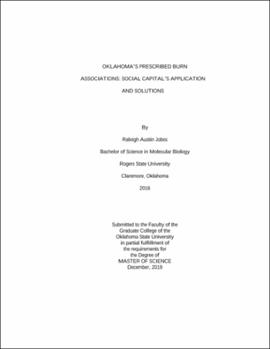| dc.contributor.advisor | Gill, Duane | |
| dc.contributor.author | Jobes, Raleigh Austin | |
| dc.date.accessioned | 2020-06-29T17:39:46Z | |
| dc.date.available | 2020-06-29T17:39:46Z | |
| dc.date.issued | 2019-12 | |
| dc.identifier.uri | https://hdl.handle.net/11244/324926 | |
| dc.description.abstract | Over the past millennia anthropogenic changes to natural environments have compounded into problematic and devastating effects. Among these problems are the increased presence of wildfires and loss of historical grassland habitats in Oklahoma. Oklahoma’s Prescribed Burn Associations (PBAs) seek to use prescribed fire to remediate environmental degradation and increase potential for financial returns on land management practices. However, these groups face social barriers to their practices, limiting the ability to engage in social uses of prescribed fire. PBAs are not-for-profit groups primarily composed of rural landowners, farmers, and ranchers. So far, sociological contributions are limited and do not concentrate on PBAs’ perspectives for what limits or supports social uses of fire. My qualitative research focuses on PBAs’ social capital and the success and barriers they face as they navigate social networks and interact with groups with varying levels of similar of dissimilar fire management ideologies. For this reason five volunteer fire department and 15 PBA member were interviewed in a semi-structured format. By situating this research in the Community Capitals Framework, I provided context to sociological insights that can be more readily adapted for landowner use and understanding. The primary sociological focus stems from concepts in social capital theories. Bonding, bridging, and linking social capital helped define and direct this research to better capture PBA member responses. The semi-structured interviews yielded findings that suggest PBAs engage with social uses of fire for both anthropocentric and ecocentric purposes. Social barriers were lessened when direct personal interaction occurred to provide information about prescribed fires and connection to PBAs. Furthermore, directly seeing prescription effects increased public acceptance of prescribed fires. Volunteer fire departments were open to concepts of prescribed fire when personal contacts were made and PBAs followed prescription protocols. Implications of these findings suggest that PBAs’ social capital is capable of accessing a wide variety of stakeholders. | |
| dc.format | application/pdf | |
| dc.language | en_US | |
| dc.rights | Copyright is held by the author who has granted the Oklahoma State University Library the non-exclusive right to share this material in its institutional repository. Contact Digital Library Services at lib-dls@okstate.edu or 405-744-9161 for the permission policy on the use, reproduction or distribution of this material. | |
| dc.title | Oklahoma's Prescribed Burn Associations: Social capital's application and solutions | |
| dc.contributor.committeeMember | Weir, John | |
| dc.contributor.committeeMember | Grey, Benjamin J. | |
| dc.contributor.committeeMember | Ritchie, Liesel | |
| osu.filename | Jobes_okstate_0664M_16598.pdf | |
| osu.accesstype | Open Access | |
| dc.type.genre | Thesis | |
| dc.type.material | Text | |
| dc.subject.keywords | community capitals | |
| dc.subject.keywords | prescribed burn association | |
| dc.subject.keywords | prescribed fire | |
| dc.subject.keywords | social capital | |
| thesis.degree.discipline | Sociology | |
| thesis.degree.grantor | Oklahoma State University | |
